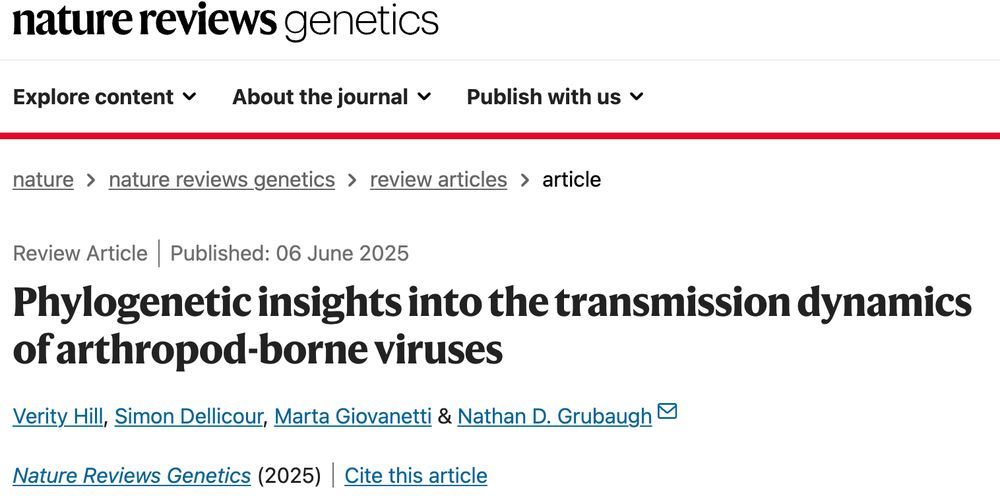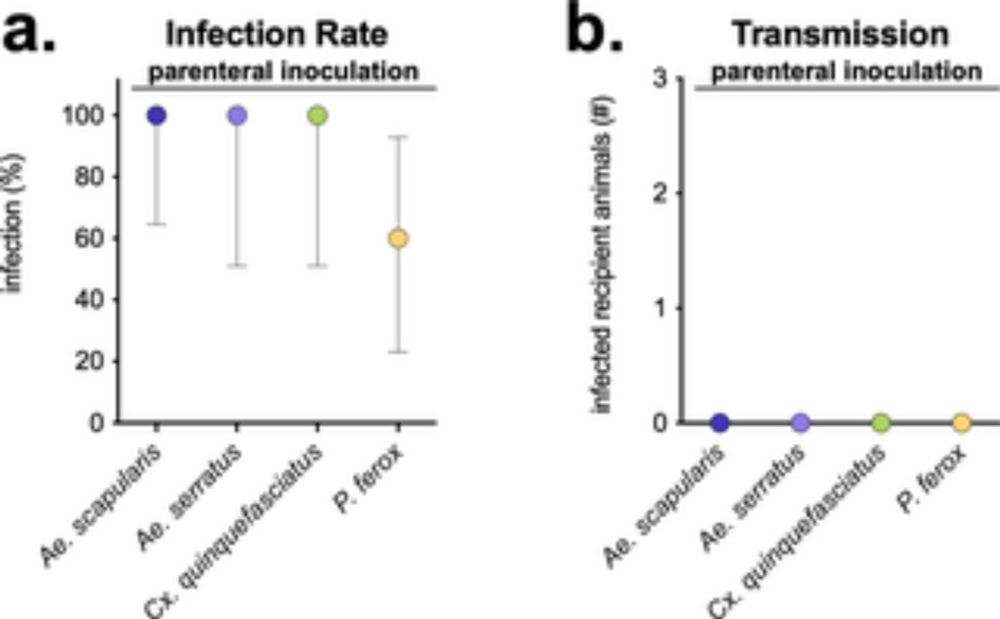
Community survey on the addition of Dengue, Chikungunya, Oropouche, Zika and Yellow fever virus to Pathoplexus
Pathoplexus is a new platform for sharing pathogen sequence data, launched in August 2024 [1], with the primary aim of making sharing and accessing pathogen genomic data easier, faster, and more effic...
@andersonfbrito.bsky.social and I are seeking input from the community on hosting/sharing arbovirus sequencing data (DENV, CHIKV, OROV, ZIKV, & YFV) on @pathoplexus.org.
Please consider filling out this VERY SHORT survey about your interest and/or concerns.
docs.google.com/forms/d/e/1F...
30.10.2025 20:11 — 👍 15 🔁 12 💬 1 📌 0
In Brazil universities has little nicknames too, and usually we just called by them. Like: UFRGS (universidade federal do Rio Grande do Sul), USP (Universidade de São Paulo), UFRJ, PUC….
Just figure out now that for most universities worldwide this is not common 🤓
26.08.2025 13:00 — 👍 0 🔁 0 💬 0 📌 0
Beyond Oropouche virus, this strategy can also be applied to monitor other vector-borne diseases — such as dengue, Zika, and chikungunya — which are increasing due to climate change. It remains effective even when laboratory capacity is strained by concurrent outbreaks.
12.08.2025 17:19 — 👍 0 🔁 0 💬 0 📌 0

Interested in using phylogenetics to study arboviruses? Our new review in @natrevgenet.nature.com by @viralverity.bsky.social, @sdellicour.bsky.social, and Marta Giovanetti has you covered!
📖 👉 rdcu.be/epH2U
Short 🧵
09.06.2025 14:02 — 👍 52 🔁 23 💬 2 📌 0
Amazing 👏👏👏
27.05.2025 22:59 — 👍 1 🔁 0 💬 1 📌 0

Final version just online now!
27.05.2025 15:58 — 👍 1 🔁 1 💬 0 📌 0

Re-emergence of #Oropouche virus as a novel global threat.
A novel reassortant OROV lineage drives the 2023–2025 outbreak in the Americas. Over 23,000 cases confirmed, with expansion into non-endemic regions.
www.sciencedirect.com/science/arti... #OpenAccess
19.05.2025 18:32 — 👍 6 🔁 5 💬 0 📌 0

A key concern with OROV reemergence is its potential to spread into previously unaffected regions, as we have seen with other arboviruses like dengue. This highlights the urgent need for strengthened surveillance and monitoring of both the virus and its vectors.
21.05.2025 14:09 — 👍 0 🔁 0 💬 1 📌 0

In this review, I explore the historical epidemiology of Oropouche fever, its growing public health relevance, and emerging clinical challenges. I also highlight key research gaps, especially in vector competence and the need for a standardizedm genomic lineage system.
21.05.2025 14:09 — 👍 0 🔁 0 💬 1 📌 0
Awesome! Congrats @isabelott.bsky.social 🎉👏👏👏
09.04.2025 02:09 — 👍 1 🔁 0 💬 0 📌 0
Just out! Our recent work showing the factors leading dengue expansion to a non-endemic temperate region.
25.02.2025 19:57 — 👍 2 🔁 1 💬 0 📌 0
Just out our preprint on the concerning spread of Oropouche virus to non-endemic regions in Brazil. This shift could have significant public health implications.
22.02.2025 00:05 — 👍 4 🔁 2 💬 0 📌 0

Check out our latest paper: 'Severe dengue-related deaths among the elderly surged in Southern Brazil in 2024,' highlighting the ongoing rise in dengue cases and alarming lethality rates in this region. #Dengue #Brazil #PublicHealth
doi.org/10.1016/j.ij...
11.02.2025 16:02 — 👍 7 🔁 2 💬 0 📌 1
This a summary of last part o my Ph.D. We investigated how temperature can affect the outcome of dengue infection.
The study covers a 10y period in all five regions of Brasil and all sub-climates of the country
We conclude that higher temperature makes risk of hospitalizations due dengue bigger!
11.02.2025 15:49 — 👍 19 🔁 12 💬 1 📌 0
Fantastic work @rafalpx.bsky.social ! Congrats!!!
11.02.2025 16:01 — 👍 4 🔁 0 💬 0 📌 0
Congrats @rafalpx.bsky.social @nathangrubaugh.bsky.social !!!
08.01.2025 23:06 — 👍 2 🔁 0 💬 0 📌 0

Our latest paper revealed Multiple introductions and sustained local transmission of Monkeypox virus in Southern Brazil between 2022–2023.
www.tandfonline.com/doi/full/10....
08.01.2025 20:27 — 👍 1 🔁 0 💬 0 📌 0

Happy to share our recently published work!
We've developed an all-in-one protocol for tiling sequencing and host identification of Rabies Virus Bat-Clade.
Check it out:
authors.elsevier.com/a/1kGHsbm%7E...
03.01.2025 19:57 — 👍 2 🔁 0 💬 0 📌 0

Sharing our work expanding SARS-CoV-2 style tiled amplicon sequencing for whole bacteria genomes directly from clinical samples, showing examples with M.tb (>4 mb) and Strep pneumo (>2 mb).
Led by Chaney Kalinich, Freddy Gonzalez, & Seth Redmond
www.biorxiv.org/content/10.1...
20.12.2024 20:45 — 👍 75 🔁 33 💬 1 📌 3
Research assistant professor PI, Cross Flavi Lab @Pitt | Flavivirus antibody response & cross-flavivirus interactions | Epidemiology & Capacity Building | UC Berkeley affiliate
Virologist at Fiocruz Brazil | Phylogenetics, Molecular Evolution & Genomic Epidemiology
Assistant Professor @ UC Berkeley Public Health
Director, Pandemic & Epidemic Threat Analysis Lab (PETAL)
https://publichealth.berkeley.edu/people/charles-whittaker
https://whittakerlab.com/
epidemiology | evolution | ecology of infectious diseases
Asst Prof of Epidemiology (she/her) U of Utah
views are mine alone
Ph.D. Health Sciences; Bioinformatics; Postdoctoral fellow at FIOCRUZ-BA
phd student @yalesph | nsf graduate research fellow | viruses 🦠, vectors 🦟, and climate change 🌎 | usc alum ✌🏻| kansan 🌻 | (she/her)
Father of three (👧👧🐶), professor of Virology @ufesoficial.bsky.social and scientist focused on viral eco-epidemiology, diversity, and evolution. He/him. PI @lagev-ufes.bsky.social
An open-source pathogen sequence database dedicated to equitable sharing, transparent governance, & empowering global public health.
pathoplexus.org
Scientist | pHD candidate | Immunology
https://www.unimedizin-mainz.de/medizinische-mikrobiologie-und-hygiene/
#DGfI #DGHM #EFIS #IUIS / 🦖☄️🦠🔬🧫🐁🧍/ #immunometabolism / #host-pathogen interaction / 🇪🇺 / #UM #JGU: excellence in basic research and health care / own views only
We're a research lab at Rockefeller University (NY) and Necker Hospital (Paris) studying human genetic and immunological determinants of infectious diseases.
https://www.hgid.org/
We work on planetary problems. Currently: counting climate change-related deaths; pandemic risk assessment in a changing biosphere; data, science, and vaccine access during public health emergencies. 👉 carlsonlab.bio
infectious diseases physician + Prof @Stanford
tuberculosis, typhoid, diagnostics, genomic epidemiology, carceral health
https://med.stanford.edu/profiles/jason-andrews
amplifying WaSH Water Sanitation Hygiene SDG6 Water Security Waste Water Management & Reuse publications & posts in the tiny hope of advancing the flow of information from one to another Cambridge Massachusetts (+ Ground water Hydrology Heath issues)
Evolutionary & population biology of vector-borne viral disease systems. 🦟 genetics PhD student in NC.
Arbovirologist, orthobunyavirus wonk, feral reference librarian, & public health advocate. 80s mosquito. Coaster-sized earrings. (she/her) 🏳️🌈
Epidemiologist at UIUC, working in One Health
virtual seminars on arbovirus biology, by the community for the community (organised by Tem Morrison, @tulilab.bsky.social and
@clive-mckimmie.bsky.social
Yale MPH '25, Infectious Disease Epidemiology. Former museum worker, future public health professional. 🧪 Latina in STEM 💃🏻 | Phylo & Infectious Disease Lover | Genomics & Evolution | She/Her 👩🔬


















